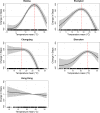The effect of temperature on physical activity: an aggregated timeseries analysis of smartphone users in five major Chinese cities
- PMID: 35701809
- PMCID: PMC9195465
- DOI: 10.1186/s12966-022-01285-1
The effect of temperature on physical activity: an aggregated timeseries analysis of smartphone users in five major Chinese cities
Abstract
Background: Physical activity is an important factor in premature mortality reduction, non-communicable disease prevention, and well-being protection. Climate change will alter temperatures globally, with impacts already found on mortality and morbidity. While uncomfortable temperature is often perceived as a barrier to physical activity, the actual impact of temperature on physical activity has been less well studied, particularly in China. This study examined the associations between temperature and objectively measured physical activity among adult populations in five major Chinese cities.
Methods: Aggregated anonymized step count data was obtained between December 2017-2018 for five major Chinese cities: Beijing, Shanghai, Chongqing, Shenzhen, and Hong Kong. The associations of temperature with daily aggregated mean step count were assessed using Generalized Additive Models (GAMs), adjusted for meteorological, air pollution, and time-related variables.
Results: Significant decreases in step counts during periods of high temperatures were found for cold or temperate climate cities (Beijing, Shanghai, and Chongqing), with maximum physical activity occurring between 16 and 19.3 °C. High temperatures were associated with decreases of 800-1500 daily steps compared to optimal temperatures. For cities in subtropical climates (Shenzhen and Hong Kong), non-significant declines were found with high temperatures. Overall, females and the elderly demonstrated lower optimal temperatures for physical activity and larger decreases of step count in warmer temperatures.
Conclusions: As minor reductions in physical activity could consequentially affect health, an increased awareness of temperature's impact on physical activity is necessary. City-wide adaptations and physical activity interventions should seek ways to sustain physical activity levels in the face of shifting temperatures from climate change.
Keywords: China; Physical activity; Step count; Temperature; Urban.
© 2022. The Author(s).
Conflict of interest statement
The authors declare that they have no competing interests.
Figures


Similar articles
-
Associations between mortality and meteorological and pollutant variables during the cool season in two Asian cities with sub-tropical climates: Hong Kong and Taipei.Environ Health. 2013 Jul 19;12:59. doi: 10.1186/1476-069X-12-59. Environ Health. 2013. PMID: 23870087 Free PMC article.
-
Association between high temperature and mortality in metropolitan areas of four cities in various climatic zones in China: a time-series study.Environ Health. 2014 Aug 7;13:65. doi: 10.1186/1476-069X-13-65. Environ Health. 2014. PMID: 25103276 Free PMC article.
-
Extremely cold and hot temperatures increase the risk of ischaemic heart disease mortality: epidemiological evidence from China.Heart. 2013 Feb;99(3):195-203. doi: 10.1136/heartjnl-2012-302518. Epub 2012 Nov 13. Heart. 2013. PMID: 23150195
-
Part 2. Association of daily mortality with ambient air pollution, and effect modification by extremely high temperature in Wuhan, China.Res Rep Health Eff Inst. 2010 Nov;(154):91-217. Res Rep Health Eff Inst. 2010. PMID: 21446212
-
Association between moderately cold temperature and mortality in China.Environ Sci Pollut Res Int. 2020 Jul;27(21):26211-26220. doi: 10.1007/s11356-020-08960-5. Epub 2020 May 2. Environ Sci Pollut Res Int. 2020. PMID: 32361971
Cited by
-
The Impact of Temperature on 24-Hour Movement Behaviors among Chinese Freshmen Students.Int J Environ Res Public Health. 2023 Mar 11;20(6):4970. doi: 10.3390/ijerph20064970. Int J Environ Res Public Health. 2023. PMID: 36981878 Free PMC article.
-
Sensing the impact of extreme heat on physical activity and sleep.Digit Health. 2024 Mar 24;10:20552076241241509. doi: 10.1177/20552076241241509. eCollection 2024 Jan-Dec. Digit Health. 2024. PMID: 38528970 Free PMC article.
-
The joint effects of mixture exposure to multiple meteorological factors on step count: A panel study in China.Environ Pollut. 2024 Apr 1;346:123469. doi: 10.1016/j.envpol.2024.123469. Epub 2024 Feb 21. Environ Pollut. 2024. PMID: 38395131 Free PMC article.
-
Factors affecting outdoor physical activity in extreme temperatures in a sub-tropical Chinese urban population: an exploratory telephone survey.BMC Public Health. 2023 Jan 14;23(1):101. doi: 10.1186/s12889-022-14788-0. BMC Public Health. 2023. PMID: 36641429 Free PMC article.
-
Investigation of seasonality of human spontaneous physical activity and energy expenditure in respiratory chamber in Phoenix, Arizona.Eur J Clin Nutr. 2024 Jan;78(1):27-33. doi: 10.1038/s41430-023-01347-y. Epub 2023 Oct 13. Eur J Clin Nutr. 2024. PMID: 37833567
References
Publication types
MeSH terms
LinkOut - more resources
Full Text Sources
Research Materials

